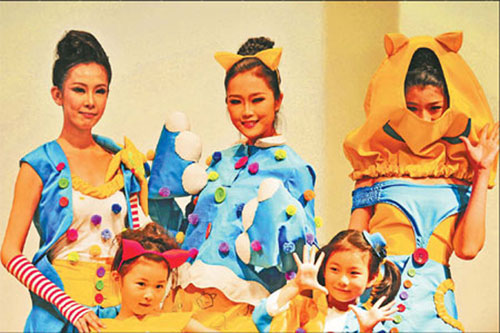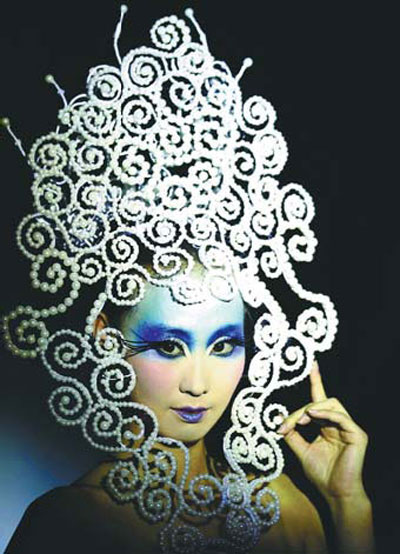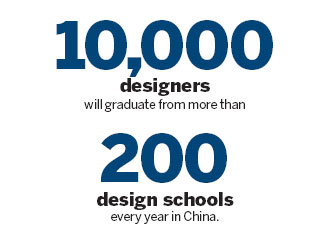A fashion force by design
Updated: 2011-08-15 11:08
By Lin Jing (China Daily)
|
|||||||||||
 |
| Works by graduating students at Wuhan University's fashion department are shown off in Wuhan, Hubei province. Shepherd C. Zhou / for China Daily |
 |
| An elaborate headpiece worn at a fashion show at Beijing's 798 Art Zone. Wang Jing / China Daily |

As nation strives to make its mark on the world's catwalks, it is doubling efforts to nurture more designers. Lin Jing reports.
The country is in desperate need of fashion designers as it seeks to transform itself from being manufacturer to becoming a creator. "There is a great demand for designers in the market," says Su Baoyan, secretary-general of the China Fashion Association. "Currently there are about 50,000 apparel companies in China and new brands keep popping up every year. Besides, some existing brands are also developing new lines. All of these companies need fashion designers."
She says demand outstrips supply, even though 10,000 designers graduate each year.
Su says that after the 2008 global financial crisis, manufacturers in the coastal areas of South China have seen fewer manufacturing orders from developed countries.
To stay afloat, these companies have to adjust their business models and transform from being just manufacturers. "Designers play a key role in the transformation from 'made-in-China' to 'designed-in-China'. Without them, it's mission impossible," Su says.
Consumer needs are evolving rapidly in China and apparel brands are growing increasingly aware that they have to change accordingly.
"The demand for fashion designers, especially experienced ones, keeps increasing," Su says.
Lan Lan, a lecturer with the Beijing Institute of Fashion Technology, says that China is relatively new to the fashion world, which can be a hindrance to up-and-coming designers.
"In China, the fashion industry does not have a long history like in the West. Foreign designers have known about, seen and used many fashion products during their early years, while most Chinese fashion designers may have not even heard of these fashion brands till their college years. As a result, they have to make up the gap within a short period of time."
There are more than 200 design schools in China, but classes tend to emphasize creativity over business.
"Fashion designers are different from artists. Artists work for themselves and can let their imagination fly, while designers have to be more organized and business-orientated," Lan says.
Lan adds a fashion designer is in charge of the process from product design to final delivery, including fabric choices, cost control and targeting customers.
"Designers have to bear business and customers' needs and requirements in mind. Their designs and products are supposed to be understandable to their bosses and target clients and help increase sales," she says.
Federick Wong, program director of the fashion design department at Raffles Design Institute in Beijing, says the most urgent issue is finding a way to nurture new designers.
"To become professional fashion designers, school training is far from enough. And young designers need a good platform to grow and mature after graduation."
Wong, a Chinese-Malaysian, says that it takes at least five years of working experience to become a professional designer.
Wong suggests the government should, besides setting up design schools, give young designers more opportunities to get hands-on experience.
"Fashion schools could set up incubation centers for young designers to experiment with their ideas, business plans and designs," he says. "More cooperation between schools and apparel companies in real-time projects is also helpful. These projects could familiarize young designers with the industry much earlier and help enterprises select the designers they need."
Wong says that most Chinese fashion designers find it hard to promote themselves.
Fashion shows can help advertise new designers, but it can be a struggle financially to start a new business.
"The starting monthly salary for a designer is about 3,000 yuan ($469) to 5,000 yuan. But a one-hour fashion show costs around 1 million yuan ($156,345), not including the cost of staging, lights, music and models, which is beyond the financial abilities of most young designers."
German fashion designer Katrin Reinfurt says that young Chinese fashion designers have great potential to become globally well known, and what China needs is a fashion district.
"International fashion designers are well-known for fine marketing and big shows in fashion centers such as Paris, but it is difficult for Chinese fashion designers to hold fashion shows in Europe, because of the distance and huge costs," she says.
"The problem in China is that it does not have a gathering place where fashion media, journalists, designers and models can come together and join the marketing process."
In recent years, many foreign designers and studios have started up in China, especially in big cities. Although the number of foreign designers is quite small, they are popular.
"Big apparel companies prefer foreign designers to local ones, because foreign designers can raise their products' reputation. They are also better able to grasp fashion trends and are more adept at color coordination," Lan says.
Because of this, Western designers are very popular in emerging markets including China.
"However, when it comes to the local market, Chinese designers still have some advantages because they understand local cultures and customers' preferences much better," she says.
Reinfurt says that Chinese designers look too much to fashion cultures from the West and are short of originality in their own designs. In the long term, he says, Chinese designers should form their own style.
"Instead of drowning in the other trends, they (Chinese designers) should try to concentrate on their own culture, and find out their own design signatures," Reinfurt says.
"Fashion design is like a mirror of society. Designers should combine their designs with Chinese culture, learn to express their own identities and dress codes, and reflect what is going on in society."
Jacky Jin, vice-president of Trends Media Group, a fashion magazine publisher in China, says that there is still a lot of room for improvement for Chinese designers.
"In the West, fashion designers are not only designers, but also fashion icons who provide ideas and promote fashion styles, such as John Galliano and Karl Lagerfeld," Jin says. "But in China, designers are confined to a certain role."
Since the 1990s, some Chinese designers have chosen to study in countries known for producing great fashion, such as the United Kingdom, Italy and France.
Jin says that it is really helpful for them to see different things and open their eyes and minds.
"These Chinese designers have a thorough understanding of local markets by working or interning in international apparel companies," he says.
"Armed with advanced management skills and experience, they have great potential to become world-class designers."